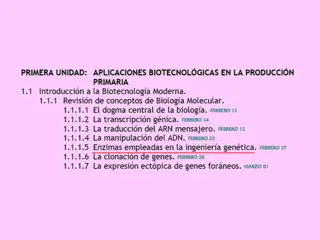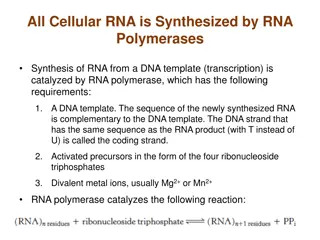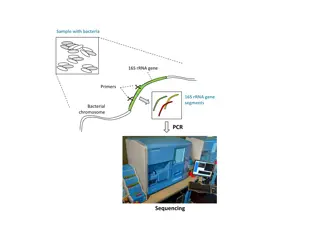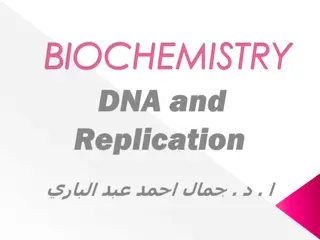Overview of Key Enzymes in Modern Biotechnology
This content provides insights into important enzymes used in modern biotechnology, focusing on DNA ligases and polymerases. It delves into the structures, mechanisms, and characteristics of these enzymes, such as Taq polymerase and bacteriophage T4 DNA ligase. Through detailed descriptions and imag
0 views • 15 slides
Understanding DNA Transcription and Translation in Biology
DNA transcription is the process where DNA is used as a template to create mRNA in the nucleus. This mRNA is complementary to the DNA and goes through initiation, elongation, and termination stages. RNA polymerases are essential for this process in eukaryotes. Various RNA polymerases have specific f
0 views • 47 slides
Understanding RNA Polymerases and Transcription Process
RNA polymerases play a crucial role in synthesizing cellular RNA through transcription, where RNA is created from a DNA template. This process involves specific requirements such as a DNA template, ribonucleoside triphosphates, and divalent metal ions. RNA polymerase catalyzes the initiation and elo
0 views • 15 slides
Understanding Chimeric Artifacts in Bacterial 16S rRNA Gene Sequencing
This content explores the formation of chimeric artifacts during PCR amplification of bacterial 16S rRNA gene segments, leading to challenges in biological sequence clustering and detection. It delves into the complexities of distinguishing between homologous and non-homologous crossover chimeras, p
0 views • 47 slides
Overview of Thermostable DNA Polymerases and Their Properties
Thermostable DNA polymerases play a crucial role in various molecular biology techniques, with Taq DNA polymerase being a household name due to its discovery in Thermus aquaticus. These enzymes catalyze DNA synthesis, require magnesium ions for activity, and exhibit optimal function at high temperat
0 views • 8 slides
Understanding Polymerase Chain Reaction (PCR) in Genetic Engineering
Polymerase Chain Reaction (PCR) is a key enzymatic method in genetic engineering developed in 1983. It amplifies targeted regions of DNA, aiding in various applications like studying diseases, forensic analysis, and analyzing ancient DNA. PCR involves heating, denaturation, primer binding, and exten
0 views • 14 slides
Insights into DNA Replication and Chromosome Structure
DNA replication is a fundamental process vital for the transmission of genetic information. Chromosomes, composed of DNA-protein complexes, store genetic information, and replication involves the synthesis of new DNA molecules. Enzymes play crucial roles in DNA synthesis, and in E. coli cells, repli
0 views • 16 slides






